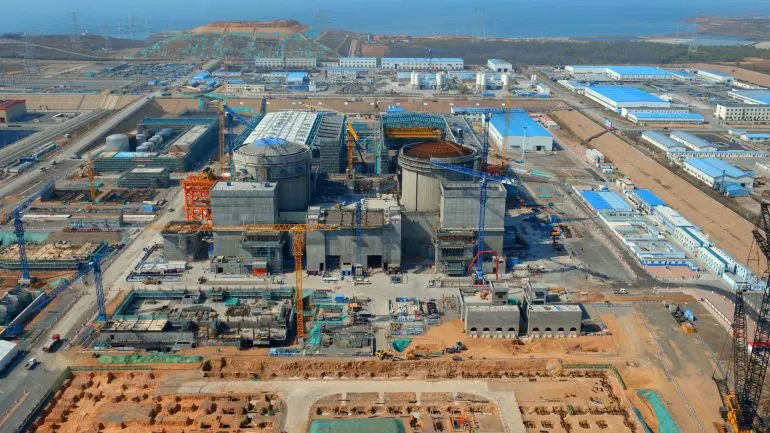The biggest nuclear power plants in the world generate enough electricity to power millions of homes, businesses, hospitals, schools, and more. Their sheer scale and output are enough to astound, but it’s the relevance and benefits to modern society that transform them from complex engineering marvels into indispensable pillars of our global energy infrastructure.
The world’s biggest nuclear power plants are believed to supply approximately 10% of the world’s electricity. As the world grapples with climate change, the role of nuclear energy in providing a significant portion of our low-carbon electricity becomes increasingly relevant.
In this list, the biggest nuclear plants in the world are measured by nameplate capacity, a term used to describe the maximum amount of electricity a nuclear power station can produce under ideal conditions. The actual amount of electricity produced may vary due to a number of factors, but nameplate capacity offers a useful baseline for understanding potential output.
Let’s shed some light – literally and metaphorically – on the world’s largest nuclear power plants.
Gravelines Nuclear Power Station

Gravelines (Photo by PHILIPPE HUGUEN/AFP via Getty Images)
Location: Nord, France | Brought online: 1980 – 1985 | Capacity: 5,460 MW
Just twenty miles from Calais, Gravelines may not be the most powerful nuclear power plant in the world, but in 2017 it produced over 31.5 TWh (terawatt-hours) of electric energy, roughly six percent of French electricity production. The six nuclear reactors produce 910 MW each for a nameplate capacity of 5,460 MW, and its cooling water comes direct from the North Sea.
Zaporizhzhia Nuclear Power Plant

Zaporizhia Nuclear Power Station, Enerhodar, Ukraine (Credit: OlyaSolodenko via Getty Images)
Location: Enerhodar, Ukraine | Brought online: 1985 – 1996 | Capacity: 5,700 MW
The largest nuclear power station in Europe and one of the largest nuclear power plants in the world, Zaporizhzhia has six pressurised light water reactors each generating a maximum of 950 MW each. The annual net output from 2016 (the latest available figure) is around 38,000 GWh (gigawatt-hours). This is reported to be around half of the country’s electricity from nuclear power.
Bruce Nuclear Generating Station

Bruce Nuclear Plant (Photo: Bernard Weil/Toronto Star via Getty Images)
Location: Ontario, Canada | Brought online: 1977 – 1987 | Capacity: 6,550 MW
With eight pressurised heavy water reactors, Bruce Nuclear Generating Station on the shore of Lake Huron was the biggest nuclear power plant in the world until 2016. The vast site covers 2,300 acres and in total over its operational lifetime, the plant is believed to have generated over 1.5 million GWh.
Hongyanhe Nuclear Power Plant

Hongyanhe Nuclear Power Plant (Photo by TPG/Getty Images)
Location: Liaoning Province, China | Brought online: 2013 – 2022 | Capacity: 6,710 MW
At a reported cost of around £2.6 billion, the biggest nuclear power plant in China, located in the northeast of the country, reached full operational capacity in June 2022 with six pressurised light water reactors generating 1,118 MW each. The first reactor began commercial operation in June 2013.
Hanul Nuclear Power Plant

Inside A Fusion Reactor. (Credit: Monty Rakusen via Getty Images)
Location: South Korea | Brought online: 1988 – 2022 | Capacity: 7,268 MW
In the eastern province of Gyeongsangbuk-do, the Hanul NPP is one of the world’s largest nuclear power plants with an annual net output of 39,795 GWh (2016). It currently has seven operational pressurised water reactors with three under construction. When the plant has all ten reactors in operation, the nameplate capacity is reported to be over 11,000 MW.
Kori Nuclear Power Plant

Shin-Kori 3 and 4 (Photo credit: JUNG YEON-JE/AFP via Getty Images)
Location: Busan, South Korea | Brought online: 1978 – 2019 | Capacity: 7,489 MW
The Kori Nuclear Power Plant is the most powerful nuclear power plant in the world. The plant has seven remaining operational pressurised water reactors after the first reactor, which began operations in 1978, was permanently decommissioned in June 2017. It has been reported that the decommissioning of the first reactor will take fifteen years at a cost of around $640 million. The water used to cool the reactors comes from the Sea of Japan.
Kashiwazaki-Kariwa Nuclear Power Plant

Kashiwazaki Kariwa Nuclear Power Station (Photo: Soichiro Koriyama/Bloomberg via Getty Images)
Location: Niigata Prefecture, Japan | Brought online: 1985 – 1997 | Capacity: 7,965 MW
Technically the largest nuclear power plant in the world, Kashiwazaki-Kariwa NPP is the 1,000-acre home to the world’s first advanced boiling water reactors (ABWRs), however the plant has temporarily ceased operations. In 2007, a 6.6 magnitude earthquake with an epicentre just nineteen kilometres from the plant damaged the infrastructure beyond design basis. The plant shut down completely for just under two years when four reactors were restarted. Following the Fukushima nuclear power plant accident caused by an earthquake in March 2011, the four operational reactors were again shut down. The plant remains inactive at time of writing.











